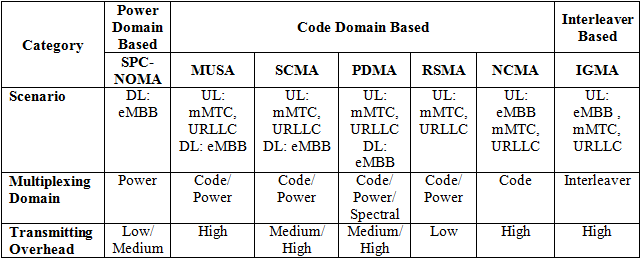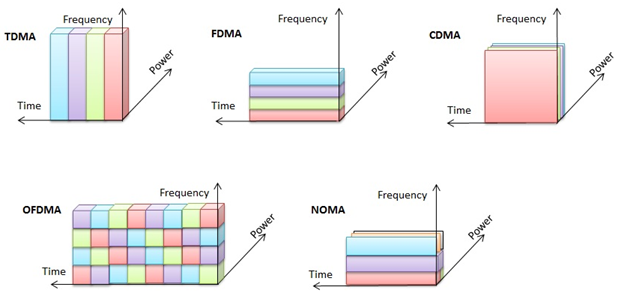| |
5G – the 5th Generation mobile technology might arrive at our door steps sooner than we think, supporting 3 typical usage scenarios: enhanced Mobile Broadband (eMBB), massive Machine Type Communication (mMTC) and Ultra-reliable Low Latency Communication (URLLC) [1]. Though architecture wise 5G is different from its predecessors, like in any other wireless communication technology, among many other things, the Multiple Access Scheme (MAS) becomes the key for 5G and selecting the suitable scheme will ultimately decide the future and success of 5G.
MAS (aka Multiple Access Method or Channel Access Method) is required when we have to share a physical media. This is not only applicable to wireless, but also to many wired networks including bus networks and ring networks. In wireless, MAS allows several User Equipment (UE) connected to the same multi-point transmission medium to transmit over it and to share the available radio capacity. MAS is based on a multiplexing method, allowing several data streams or signals to share the same communication channel or physical medium.
Multiplexing or muxing works by combining multiple analog or digital signals into one signal over a shared medium. Space Division Multiplexing (SDM), Frequency Division Multiplexing (FDM), Time Division Multiplexing (TDM) and Code Division Multiplexing (CDM) are some examples. Therefore the MAS using FDM becomes Frequency Division Multiple Access (FDMA), TDM becomes Time Division Multiple Access (TDMA) and CDM becomes Code Division Multiple Access (CDMA). In FDMA, each user has a small part of the resource (spectrum) allocated all the time. In TDMA, each user has nearly all the spectrum allocated at a small duration of time. In CDMA, each user has all the spectrum all the time. While multiplexing is provided by the physical layer, multiple accesses also involves Media Access Control (MAC) layer.
So, in summary, Multiplexing is combining many signals on one media, while MAS is allowing many to access the media/resource at one time. Therefore, it can be stated that Multiplexing is a technique and multiple accesses is the way to use that technique.
Over the years, different generations of mobile technologies used different MASs to achieve different capabilities, more importantly the system capacity and spectral efficiency.

Note: AMPS-Advanced Mobile Phone System, GSM-Global System for Mobile communications, UMTS-Universal Mobile Telecommunications System, LTE-Long Term Evolution
All the above MASs (except CDMA), which can be called as conventional MASs, are Orthogonal Multiple Access (OMA) technologies. In OMA, different users are allocated to orthogonal resources in either time, frequency or code domain in order to mitigate Multiple Access Interference (MAI). As the expectations or the objectives of 5G (higher data rates – 100/1000 times 4G, low latency – 1ms Round Trip Time (RTT), massive connectivity, high density – 1M devices/km^2, enhanced indoor coverage etc.) are quite different from that of 4G and others, the Radio Access Technology (RAT), which is characterized by MAS, need to be flexible, reliable, energy efficient, spectral efficient and support diverse Quality of Service (QoS). OMA schemes are not sufficient to support these requirements, especially massive connectivity and diverse QoS. [2], [3], [4]
It’s worthwhile to look little deeper on the scenario of mMTC and why the current LTE or LTE- Advanced (LTE-A) will find it difficult to support mMTC. In LTE/LTE-A there are lot of interactive processes between the Node B (NB)/enhanced NB (eNB) and the UE before data is transmitted. This is ok for long time continuous sessions, as the signaling overhead averaged over time is less. However, in mMTC used in Internet of Things (IoT), the “thing” (including UE) transmits a small amount of data over s short period of time and there are millions of such “things”. Now if we use LTE/LTE-A for such a scenario, the signaling overhead suddenly becomes high and access efficiency becomes low.
Therefore, several Non-Orthogonal Multiple Access Schemes are proposed for 5G, especially to address the Machine-to-Machine (M2M) requirements. These include; Superposition Coding based Non-Orthogonal Multiple Access (SPC-NOMA), Multi –User Shared Access (MUSA), Sparse Code Multiple Access (SCMA), Pattern Division Multiple Access (PDMA), Resource Spread Multiple Access (RSMA), Non-orthogonal Coded Multiple Access (NCMA) and Interleaver-Grid Multiple Access (IGMA). The different Non-Orthogonal Multiple Access Schemes can be compared as below; [1], [5]

Note: UL-Uplink, DL-Downlink
When we design Non-Orthogonal Multiple Access Schemes, we need to consider following;
- Coverage
- Peak to Average Power Ratio (PAPR)
- Implementation Complexity
- Combination with Multiple –Input Multiple-Output (MIMO)
- Flexibility
Pictorially, TDMA, FDMA, CDMA, OFDMA and NOMA can be visualized as follows [6]. This shows how different users (denoted by different colors) gets the allocation of spectrum.

While there are multiple candidates for the 5G MAS in non-orthogonal domain, none of them seems to be a perfect choice at this point of time. As different schemes have both their merits and demerits, it’s likely that a combination of different MASs, including the conventional orthogonal schemes, will be used in 5G to achieve different objectives. However, as we get closer to 2020, where the finalized standards are expected to be released, more improvements on different schemes are possible with the expectation of all new schemes or approaches to combine different schemes. At the meantime, Research & Development Engineers and scientists will be quite busy discovering, improving and innovating the finest ingredients for the success of 5G.
References
- [1] SUN Qi, WANG Sen, HAN Shuangfeng et al., “Unified Framework Towards Flexible Multiple Access Scheme for 5G” ZTE Communications, vol. 14, no. 4, pp. 26-33, October. 2016. doi: 10.3969/j.issn.1673-5188.2016.04.004
- [2] WEI Zhiqiang, YUAN Jinhong, Derrick Wing Kwan Ng, et al., “A Survey of Downlink Non-Orthogonal Multiple Access for 5G Wireless Communication Networks” ZTE Communications, vol. 14, no. 4, pp. 17- 23, October. 2016. doi: 10.3969/j.issn.1673-5188.2016.04.003
- [3] Volker Jungnickel, Konstantinos Manolakis, Wolfgang Zirwas et al., “The Role of Small Cells, Coordinated Multipoint, and Massive MIMO in 5G” IEEE Communications Magazine, pp. 44-51, May. 2014.
- [4] Peng Wang, Jun Xiao, Li Ping, “Comparison of Orthogonal and Non-Orthogonal Approaches to Future Wireless Cellular Systems”.
- [5] YAN Chunlin, YUAN Zhifeng, LI Weimin et al., “Non-Orthogonal Multiple Access Schemes for 5G” ZTE Communications, vol. 14, no. 4, pp. 11-16, October. 2016. doi: 10.3969/j.issn.1673-5188.2016.04.002
- [6] Mahyar Shirvanimoghaddam, Sarah J. Johnson, “Multiple Access Technologies for Cellular M2M Communications” ZTE Communications, vol. 14, no. 4, pp. 11-16, October. 2016. doi: 10.3969/j.issn.1673-5188.2016.04.006
|
|